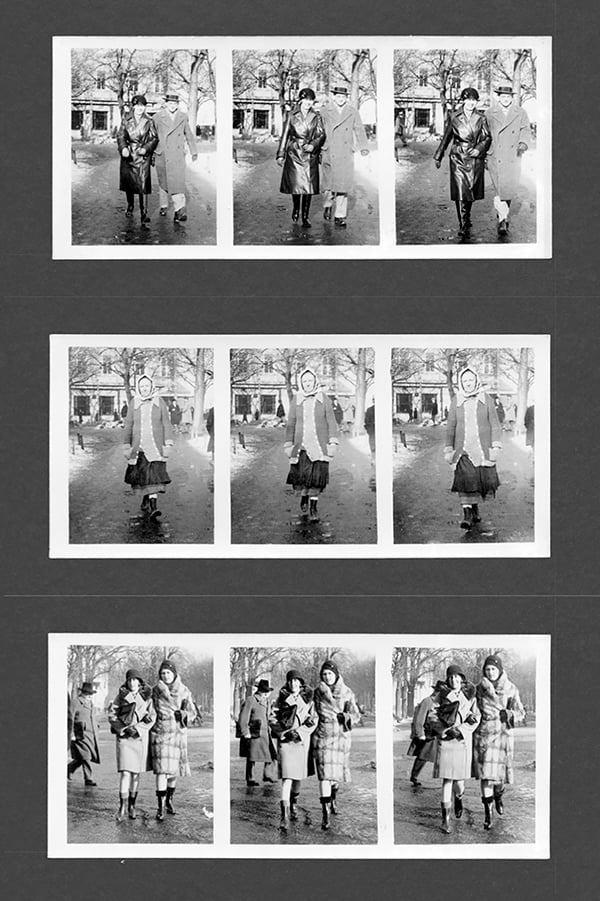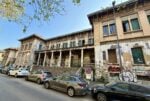Der Grazer Gehfotograf

Der Grazer Gehfotograf offre uno sguardo insolito sulla vita urbana di Graz e dei suoi abitanti tra gli anni Venti e Trenta del Novecento.
Comunicato stampa
Kuratiert von: Mila Palm, Nicolò Degiorgis
Aus der Sammlung von: Mila Palm
Ein Buch von: Rorhof
Ausstellungsdesign: Flaim Prünster Architekten
Eröffnung: 12.4.2023, 19 Uhr
Ausstellung: 13.4. - 6.5.2023
Finissage & Buchpräsentation: 6.5.2023, 11 Uhr
Die sogenannten “Gehfotografen” waren zwischen 1927 und 1935 auf den Straßen von Großstädten und touristischen Orten in ganz Europa tätig. Der Beruf wurde während der Weltwirtschaftskrise weit verbreitet, als der New Yorker Börsencrash von 1929 eine Wirtschaftskrise einläutete, die den ganzen Kontinent erfasste und deren Arbeitslosigkeit und Elend in Österreich zum Bürgerkrieg von 1934 führte.
In diesem Klima gingen die Aufträge zurück, so dass Berufsfotografen gezwungen waren, nach neuen Einnahmequellen zu suchen. So entstand das, was im angelsächsischen Kontext als “Street Photography" bekannt wurde.
Heutzutage gilt das Fotografieren an einem öffentlichen Ort ohne Zustimmung des Sujets als Verletzung der Privatsphäre. Doch im Graz der 1930er Jahre waren die Gehfotografen vor allem auf öffentlichen Plätzen aktiv, wo sie auf 35-mm-Film eine Serie von drei Bildern pro Passant aufnahmen. Belichtet und als Postkarten gedruckt, wurden die Fotos als Souvenirs an Passanten verkauft.
Ob ausgeschnitten oder in einer Brieftasche gefaltet, wurden die Fotos zu einer Art Tauschwährung zwischen dem Fotograf und diesen einfachen Leuten, die das Privileg hatten, fotografiert zu werden. Der Fotograf überreichte den Passanten einen Zettel mit den Worten: “Sie sind gefilmt worden”. Die Bilder konnten in den örtlichen Geschäften für je 1,5 Schilling abgeholt werden, was damals ungefähr dem Preis eines Mittagessens entsprach.
Der anonyme Fotograf nutzte die gestiegenen Besucherzahlen der Grazer Herbstmesse, die in den Jahren ab 1906 bis zu 60.000 Menschen in die Stadt lockte, und machte vermutlich zwischen 1927 und 1935 insgesamt über 10.000 Aufnahmen, von denen Foto Forum in der Ausstellung 1.400 Bildsequenzen präsentiert, die wahrscheinlich nie abgeholt worden waren.
Der Fotograf mit seinem Stativ musste bereits in einer längeren Distanz sichtbar gewesen sein. Die Reaktionen der Menschen auf den Anblick der Kamera sind sehr unterschiedlich, wie diverse Aufnahmen in der Ausstellung zeigen: Nicht alle waren davon positiv überrascht und lächelten der Kamera entgegen. Viele wirkten unbeholfen, überrascht, misstrauisch bis irritiert. Nur ein Teil der Abgebildeten ergriff die Möglichkeit, das Bild mitzugestalten und zu posieren.
Als Alltagsfotografie war ihnen oft nur eine kurzfristige Existenz beschienen und nur wenige Beispiele sind erhalten geblieben. Der Umfang dieses Bestands erscheint in dieser Hinsicht besonders reizvoll. Er bietet nicht nur einen umfassenden Einblick in das Straßenleben von Graz der 1920er und 1930er Jahre, sondern auch einen einmaligen Querschnitt der Grazer Gesellschaft. Erfasst wurden auch jene Personen, die sich diese Fotografien nicht leisten konnten, zumal es sich um jene Beispiele handelt, die nicht abgeholt wurden.
Die Straßenfotografen waren ein Phänomen das unter den heutigen Bestimmungen nicht mehr existieren könnte. Andererseits ist die Videoüberwachung unserer Straßen zum Alltag geworden.
Die gezeigten Bilder werfen nachdenklich stimmende Fragen über die Privatsphäre heute und damals auf. Vor allem aber dokumentieren sie auf subtile und kaleidoskopische Weise, wie der Bürgersteig zum Laufsteg wurde.
Am 6. Mai um 11 Uhr laden wir Sie herzlich zur Finissage mit Buchpräsentation ein.
IT
A cura di: Mila Palm, Nicolò Degiorgis
Da una collezione di: Mila Palm
Un libro di: Rorhof
Allestimento: Flaim Prünster Architekten
Inaugurazione: 12.4.2023, h19
Mostra: 13.4. - 6.5.2023
Finissage & Presentazione del libro: 6.5.2023, ore 11
I Gehfotografen, letteralmente "fotografi ambulanti", furono attivi per le strade delle città e nelle località turistiche di tutta Europa tra il 1927 e il 1935. La professione si diffuse capillarmente durante la Grande Depressione, quando il crollo della borsa di New York del 1929 sancì una crisi economica che afflisse l’intero continente e le cui conseguenti disoccupazione e povertà culminarono nella guerra civile austriaca del 1934.
In questo clima, le committenze diminuirono, costringendo i fotografi professionisti a cercare nuove fonti di reddito. Fu così che nacque quella che nel contesto anglosassone prese poi il nome di “street photography”.
Oggigiorno fotografare in un luogo pubblico senza consenso costituisce una violazione della privacy. Eppure, nella Graz degli anni Trenta, i Gehfotografen furono soprattutto attivi nei luoghi pubblici, dove erano soliti scattare sequenze di tre immagini per ogni passante su una pellicola da 35 mm. Una volta esposte e stampate a cartolina, le fotografie venivano vendute come souvenir ai passanti.
Ritagliate o piegate a portafoglio, le immagini divennero moneta di scambio tra il fotografo e le persone comuni che avevano avuto il privilegio di essere state immortalate. I passanti venivano solitamente avvicinati con un pezzo di carta che riportava il nome e l'indirizzo del fotografo insieme alla frase: "Lei è stato fotografato". Le foto potevano essere ritirate presso negozi del luogo per 1,5 scellini l'una, all'epoca il costo di un pranzo.
Approfittando dell'aumento del numero di visitatori che giungevano in città per la Fiera d'Autunno di Graz, che nel 1906 attirava fino a 60.000 persone, si può dedurre che l'anonimo fotografo di Graz autore degli scatti qui esposti abbia prodotto più di 10.000 immagini tra il 1927 e il 1935 circa. Foto Forum presenta 1400 tra le sequenze mai reclamate.
Con il suo treppiede, l’anonimo fotografo era ben visibile a una certa distanza. Come illustrano numerosi tra gli scatti in mostra, le reazioni delle persone alla vista della macchina fotografica variano notevolmente: alcune sono sorprese, altre sorridono, molte sembrano a disagio, sospettose o persino irritate, mentre solo alcune azzardano una posa.
Nonostante la loro valenza storica, poche sono le immagini dei Gehfotografen a noi giunte. Questo perché se al tempo della loro realizzazione erano considerate oggetti di uso comune, in particolare se non rifinite, in seguito si ridussero a vestigia di un fenomeno di breve durata.
Der Grazer Gehfotograf offre uno sguardo insolito sulla vita urbana di Graz e dei suoi abitanti tra gli anni Venti e Trenta del Novecento. Le immagini in mostra invitano a riflettere sul concetto di privacy qui e là, ora e allora. In questo senso, danno vita ad una documentazione tanto composta quanto caleidoscopica delle modalità e delle mode con le quali la popolazione di Graz trasformava i suoi marciapiedi in passerelle.
Siamo lieti di invitarLa al finissage con presentazione del libro il 6 maggio alle ore 11.00.
EN
Curated by: Mila Palm, Nicolò Degiorgis
From a collection of: Mila Palm
A book by: Rorhof
Exhibition Design: Flaim Prünster Architekten
Opening: 12.4.2023, 7 p.m.
Exhibition: 13.4. - 6.5.2023
Finissage & Book Presentation: 6 May 2023, 11 a.m.
Gehfotografen, literally “walking photographers”, were active on the streets of cities and tourist destinations across Europe between 1927 and 1935. This type of profession became increasingly popular with the Great Depression, when the 1929 collapse of the New York stock exchange led to an economic crisis throughout Europe. Unemployment and poverty eventually led to a civil war in 1934.
Under such circumstances, studio commissions fell short and professional photographers resorted to alternative sources of income. This was the beginning of what became known in the English-speaking world as street photography.
Today being photographed in a public place without consent constitutes a violation of our privacy. Yet in 1930s Graz, Gehfotografen were mostly active around public places, where they used to shoot sequences of three images per passer-by on a 35 mm film. Once exposed and printed as postcards, the photographs were sold as souvenirs to the unaware pedestrians.
Whether cropped or folded into a wallet, photographs were sold back as a currency of recognition to the same common people who had had the privilege of being shot. Passers-by were usually approached with a piece of paper reporting the name and the address of the photographer, alongside the statement: “You have been photographed”. Pictures could be collected at local shops for 1.5 Schilling each, at the time the cost of a lunch.
Taking advantage of the increased number of visitors who came to the city for the Graz Autumn Fair, which by 1906 attracted up to 60.000 people, the anonymous Graz photographer must have shot in total over 10.000 between roughly 1927 and 1935, out of which Foto Forum presents 1400 image sequences in the exhibition, which were most likely unclaimed.
With his tripod, the photographer was certainly visible from a distance. People’s reactions to the sight of the camera vary greatly, as several shots in the exhibition show: some are surprised, others smile, many seem uncomfortable, suspicious, irritated even, while only a few go as far as striking a pose.
Despite their historical interest, few examples of the work of street photographers have come down to us. If at the time of their making they were considered commonplace objects, over time they became second-class products of a short-lived phenomenon.
Der Grazer Gehfotograf offers an offbeat insight into life in Graz in the 1920s and 1930s. The images on show raise thought-provoking questions about privacy here and there, now and then. But mostly, they offer a subtle yet kaleidoscopic documentation of how the sidewalk turned into a catwalk.
We are pleased to invite you to the finissage and book presentation on May 6 at 11 a.m.



